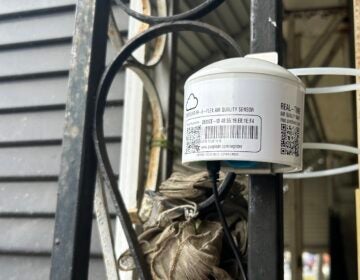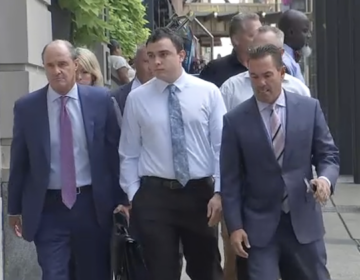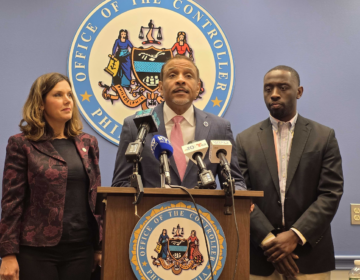Phila. Parks and Rec. explores three options to bridge the gap between Kelly Drive path and Pencoyd Bridge
Plans are on the table for a recreation trail that could close the gap between East Falls and Manayunk.
On Thursday night, Northwest residents were presented with a sneak preview of three plans that address a perceived break along the 120-mile Schuylkill River recreation trail.
Heading westbound along the Kelly Drive path, this gap begins at the Ridge Ave. bridge that crosses Wissahickon Creek, where bicyclists must hazard a narrow sidewalk shared with pedestrians before continuing on to Manayunk in the West or crossing over to Forbidden Drive to the north.
Each of the three alternative plans presented include a shared-use pedestrian/bicycle bridge that fords the Wissahickon Creek south of Ridge Ave, connecting to a recreation path that leads to the existing Pencoyd Bridge, located opposite the vacant Wilde Yarns Factory site on Main St.
From there, recreation path users would be brought briefly to Lower Merion before crossing back over to lower Venice Island and continuing through Manayunk.
“This is a crossroads,” said Daniel Biggs, an architect with the project. “It’s important that the gap is closed.”
Considering all factors and impacted properties
Funded through a Department of Conservation and Natural Resources grant in 2010 for approximately $100,000, project associates negotiated various constraints in the design of their plans, paramount among them were the competing uses for land along the parcel of land.
At present, SEPTA, PECO and the Philadelphia Canoe Club [PCC] occupy the land along the Wissahickon; private concerns occupy the balance of the land before reaching the Pencoyd Bridge. To varying degrees, all are stakeholders in the gap-mending process.
Christopher Stanford, a project manager with Baker Corporation, said that due to structural concerns, the Ridge Ave. bridge could not be expanded to accommodate additional recreation traffic, and presented three alternatives which would obviate use of the existing bridge.
Three proposals
The first alternative incorporates a 270 ft. long bridge that crosses the Wissahickon into PCC property, with a 2,100 ft. long shared use path continuing along the river’s edge to the Pencoyd Bridge. Cost estimates for this proposal are between $3.8 and $5.8 million.
According to Stanford, while this plan is the most scenic and has the advantage of being away from Ridge Ave. traffic, numerous permits and easements would need to be secured, impacts on the PCC would be significant, and there would be increased long-term maintenance. Residents present also voiced concerns about public safety.
The second plan is a variant of this, incorporating the riverside trail and utilizing a 125 ft. long bridge located further upstream on the Wissahickon. Stanford predicted the cost for this plan to be between $2.7 and $3.5 million.
This plan shares many of the advantages and challenges of the first proposal, but includes a 400 ft. long boardwalk to connect the bridge with the recreation trail, adding cost and introducing conflicting activity.
The third plan retains the upstream 125 ft. long bridge, but directs pedestrian and bicycle traffic to a 2,000 ft. shared-use path along Ridge Ave. and Main St. that ultimately connects with the Pencoyd Bridge. The estimated cost for this proposal is between $2.2 and $2.5 million.
Stanford said that this plan has the least impact on the PCC, draws upon existing right-of-ways, needs the fewest permits, and is most cost efficient in terms of construction and for long-term maintenance. With these perks come the necessity to share a driveway with PECO and forcing trail users to cross seven driveways before reaching the Pencoyd Bridge.
Neighborhood feedback
Despite these challenges, the third proposal was deemed the “preferred alternative” by Sanford, who said that its cost-effectiveness lent the upstream bridge/street-side trail the best chance of moving forward.
Gina Snyder, executive director of the East Falls Development Corporation, said that the third plan was the “best solution at this point,” calling it a “home run for the city.”
Kay Sykora, director of the Schuylkill Project, said that her organization has been involved from the beginning and supported the upstream bridge and street-side recreation trail, and noted that, “this is a tough little corner to get through.”
Sarah Clark Stuart, campaign director for the Bicycle Coalition of Greater Philadelphia, expressed concern about the crossing of seven driveways, and encouraged project managers to consider trails wider than 10 feet, suggesting that 12 to 14 feet are preferred for the high volume of usage envisioned for the trail.
Stanford said that talks are ongoing with both property owners and the Streets Department to expand the sidewalk along Ridge Ave.
Next steps and estimated timelines
Many community members present for the meeting expressed support for the project.
Manayunk resident Elly Avila observed that it would be great to be on the river someday, but said she liked the preferred alternative as a means of getting the project underway.
“We really need something this week,” she said, and highlighted the visibility of a street-side path, which would be a measure of safety for trail users.
Roxborough resident Tom Benson praised the preferred alternative, referencing the path’s heavy use as a bicycle commuter route.
“The path adjacent to Ridge Ave. and Main St. makes the connection to the rest of the bike network a little stronger,” he said, and recommended that designers consider the safe crossing of Ridge Ave. into their plans.
With the Streets Department being “on-board,” PECO agreeing to driveway use, and discussion ongoing between designers and stakeholders, Stanford said the next step is to wrap-up the feasibility study, and submit it to government agencies who must sign off on it. Similarly, work will continue with securing necessary environmental permits and easements.
If all goes according to plan, Stanford said the preliminary steps could take one to two years, with construction beginning three to four years from now.
“A lot of pieces are falling into place,” said Stanford. “There’s a lot of momentum, and we feel like we can make something happen here.
WHYY is your source for fact-based, in-depth journalism and information. As a nonprofit organization, we rely on financial support from readers like you. Please give today.




